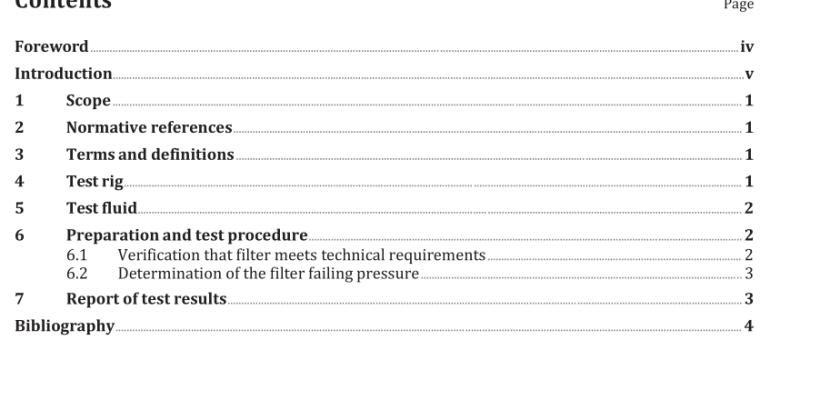ISO 4548-6:2021 pdf download – Methods of test for full-flow lubricating oil filters for internal combustion engines — Part 6: Static burst pressure test.
1 Scope This document specifies a method of testing full-flow lubricating oil filters for internal combustion engines to determine their ability to withstand a static pressure objective and to determine their burst pressure and the failure mode concerned. It does not apply to filters for use in aeronautical applications or plastic components.
2 Normative references The following documents are referred to in the text in such a way that some or all of their content constitutes requirements of this document. For dated references, only the edition cited applies. For undated references, the latest edition of the referenced document (including any amendments) applies. ISO 4548-1, Methods of test for full-flow lubricating oil filters for internal combustion engines — Part 1: Differential pressure/flow characteristics
3 Terms and definitions For the purposes of this document, the terms and definitions given in ISO 4548-1 apply. ISO and IEC maintain terminological databases for use in standardization at the following addresses: — ISO Online browsing platform: available at https://www.iso .org/obp — IEC Electropedia: available at http://www.electropedia .org/
4 Test rig Figure 1 shows a circuit diagram of a typical hydraulic test stand that can be used for this procedure. Hydraulic hand pump or other appropriate technology, with high-pressure tubing and valves, pressure gauge with measuring range of 0 kPa to 3 000 kPa or higher. A transparent safety shield shall be used.
5 Test fluid ISO Grade 22 oil with a 96 VI (or SAE 5 W oil) at ambient temperature shall be used. Alternative oil temperatures may be used as agreed upon by the filter manufacturer and customer.
6 Preparation and test procedure 6.1 Verification that filter meets technical requirements 6.1.1 Assemble a filter using the recommended tightening torque or angle of rotation. If a tolerance is given, apply the minimum tightening torque or angle of rotation. The filter to adaptor connection shall be equivalent to the production mounting conditions. When multiple samples are to be tested for statistically meaningful data, the mean and standard deviation should be calculated and reported. The rated static pressure at 95 % confidence level by Weibull analysis can be calculated and reported when tested with more than seven samples. NOTE Weibull analysis and the rated static pressure at 95 % confidence level are described in ISO 19973-1. 6.1.2 Connect the pump to the inlet of the filter or adaptor, and the outlet of the filter or adaptor to an open valve. The outlet of the valve should be the highest point of the system. 6.1.3 Introduce oil into the system by operating the pump until oil is seen to emerge from the outlet of the valve. This indicates that all the air has been excluded from the system. 6.1.4 Close the valve and position the safety shield between observer and filter.
6.1.5 Raise the pressure gradually to 200 kPa, maintain for about 1 min, and check the filter and all fittings for leaks. NOTE The first pressure increment can be 50 % of the specified objective pressure, if it is judged to be safely attainable. 6.1.6 Now raise the pressure at a controlled pressure ramp up to approximately 100 kPa per 10 s and maintain for approximately 15 s and check filter for leaks or distortion. 6.1.7 Continue raising the pressure at approximately 100 kPa per 10 s intervals with a 15 s check until a specified [see 7 g)] pressure objective is reached as determined by the customer, or otherwise failure occurs. 6.1.8 Relieve the pressure to zero. Check the filter for permanent distortion and tightening torque or angle of rotation. 6.1.9 Take note of the remaining tightening torque or angle of rotation. If loosening has occurred, restore the initial value prior to determination of the filter failing pressure specified in 6.2. If the filter failed during the verification that filter meets technical requirements, then filter failing pressure has already been determined.
